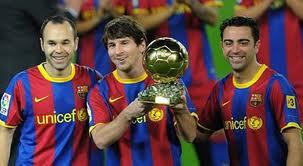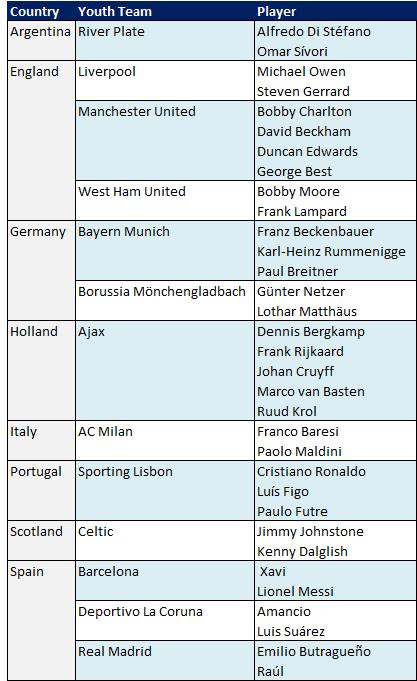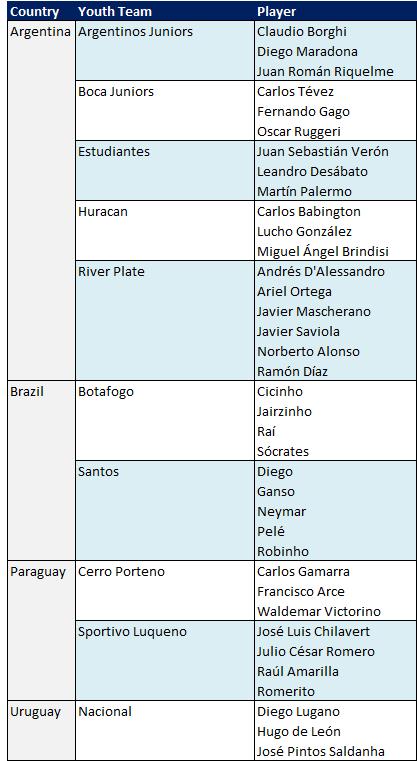In the continued quest to understand what makes a big game player, I thought I’d look into the part that youth teams play in a player’s big game temperament, or more precisely, which Youth Teams are responsible for the big game players, or in fact just a steady flow of good players. I’ll be looking at World Players of the Year, Golden Ball winners and a few other bits and pieces. As always, comments and suggestions are welcome.
Rules
For the sake of consistency, if the player has been at two youth academies, I’ll use the club that they made their professional debut with. So whilst Barcelona’s famed La Masia Academy helped produce Piqué and Fabregas, they finished their youth team education with Manchester United and Arsenal, respectively.
Each category is as per the official FIFA lists.
World Player of the Year
First things first, some lists. The first is the Worlds best players from 1991 onwards, complete with their youth team. Why 1991? Because surprisingly, that’s when the award began. From 2009 onwards, the award merged with the Ballon d’Or to become one global award. To widen the data a bit further and because there’s not always a lot in it, I’ve taken the Top three players for each year.
So is there an outstanding Youth Team that produces more World Class players (and that’s a pretty safe use of the phrase) than the others? Well yes and no. If you take Ronaldo as an example, he won the award three times and finished in the top 3 on another two occasions, meaning five entries for Brazilian club Cruzeiro. So to avoid duplication, each player is only allowed one entry. When that’s taken into account, there’s not really a run away winner.
In fact, only three clubs have had more than one representative from their youth team to finish in the top three players in the World:
- Barcelona – Lionel Messi (1st in 2009, 2010, 2011, 2nd in 2007, 2008) Andres Iniesta (2nd in 2010), Xavi (3rd in 2009, 2010, 2011)
- Sporting Lisbon – Luis Figo (1st in 2001, 2nd in 2000), Cristiano Ronaldo (1st in 2008, 2nd in 2009, 2011, 3rd in 2007)
- Ajax – Dennis Bergkamp (3rd in 1993, 1997), Marco van Basten (1st in 1992)
It’s not a massive surprise that those three clubs are where they are. A large chunk of the current Barcelona squad have at one time been graduates of the famous youth system. Aside from the trio above, you could point to Pedro, Sergio Busquets, Victor Valdes, Puyol as well as those that left before returning – Fabregas, Alba and Pique. There’s also players that went elsewhere like Mikel Arteta, Bojan Krkic, Thiago Motta, Oriel Romeu and Giovanni Dos Santos. Going back further than that and the list goes on – Pep Guardiola anyone? It’s impressive.
Sporting Lisbon aren’t exactly slouches either. Aside from the lads above, there’s Paolo Futre, Simao, Nani, and many others. Though they can’t compete with Ajax. The team that won the 1995 Champions League contained 11 youth team graduates from a match day squad of 16. And that’s just one batch. Add in the 60s-70s graduates and it’s easy to understand why they have a reputation of being the best in the World.
Other than that, there’s 28 other clubs that have produced one of the best three players in the last 22 years, ranging from AC Milan (Maldini) to West Ham United (Frank Lampard Jr).
European Footballer of the Year
So applying the same logic, I thought I’d have a look at the European Player of the Year awards (Ballon d’Or). This award goes back to 1956, giving us a wider base to look at. Up untol 1995, it was European Player only. From then onwards, it was changed to players playing in Europe, regardless of their nationality. There’s been 6 South American winners of it, if you exclude Alfredo Di Stefano who was apparently Spanish when he won it in 1957. As mentioned above, the award merged with the World Player of the Year awards in 2010, so the below data is 1956-2009.
Does it offer us a better of view of the best Youth Systems for producing big game players? Well the greater pool of players (Top 3 and sometimes 4 players if level on points) numbers at 164, giving a greater scope. Surprisingly, there’s only 13 teams that have produced more than one player to feature in the Ballon d’Or awards:
The same three that featured on the earlier list are all present, though Barca lose one player, whilst Sporting gain another, in Paulo Futre. Ajax are the single most successful youth system on this measurement with five legends of the game, and that’s with the surprising omissions of Kluivert, Davids, and Seedorf from the lists. In terms of countries, both Spain and England have three clubs represented. There’s no suprise of the three English clubs, just of the players missing.
A couple of points of note. Firstly, Raul is down as a Real Madrid youth product but actually spent a number of years on the books of Atletico Madrid. Ouch. Secondly, Luis Suarez from the Deportivo youth team isn’t the current Liverpool striker (his youth team was Nacional), but rather Barcelona, Spain and Inter Milan legend Luis Suarez Miramontes.
South American Footballer of the Year
Like the European equivalent, this award has been running for longer than the World Player of the year, dating back to 1971 when Brazil legend Tostao picked up the first award whilst playing for Cruzeiro (his youth team was America MG). In all, there’s been 130 players to finish in the Top 3 positions, from 54 different Youth Academies. Unlike the European award, there’s actually quite a lot of repeat achievers, meaning that I’ve restricted it to teams that have produced three players or more.
The award was initially for any player from South America (Mario Kempes won it whilst playing for Valencia), but after 1986, it was restricted to those players playing their football in South America and Mexico.
And so to the list:
River Plate do well – appearing on both lists, and contributing a whopping eight players to the European or South American player of the year awards. And it’s easy to see why with some of the names listed above. When you also think that they also produced Pablo Aimar, Claudio Caniggia, Gonzalo Higuain and many others, it’s easy to understand why they’re the best represented club in the lists above, but it also makes it hard to understand how they were recently relegated (before a quick promotion).
Their bitter rivals, Boca Juniors don’t do too badly either. Current Argentina Internationals, Carlos Tevez and Fernando Gago both began their careers at the club, as well as World Cup winner Oscar Ruggeri, whilst surprisingly it was Argentinos Juniors that produced Boca legends Diego Maradona and Juan Roman Riquelme. So River Plate may be more prolific, but Boca can point to one of the greatest players of all time. Which leads nicely to Pele and Santos.
Along with Pele, Santos also began the careers of Diego, Ganso, Robinho and the latest flavour of the month, Neymar, who’s the current holder of the South American Player of the Year title. Not a bad list to be fair.
Other
I was going to include the Golden, Silver and Bronze Ball awards for the three best players at the World Cup, but after reviewing the list, I decided it wasn’t as useful as first thought. For a start, Zidane (Cannes Youth Team) didn’t feature in the 1998 awards. After that, in 2002 Oliver Kahn won the award despite a massive howler in the Final, and South Korea’s Hong Myung-Bo took the Bronze Ball. I’m a pretty avid Football fan, but I have no recollection of this player, but do recall Michael Ballack, Miroslav Klose and Rivaldo having a pretty decent tournament before having to miss the Final. Furthermore, in 1986, there was no Silver or Bronze awards at all – with just Maradona and no one else – which given his impact on that World Cup, is probably fair enough, not that it was a completely one man team, although a little harsh on Top Scorer Gary Lineker (Leicester Youth Team) and one or two other decent players.
Conclusion
Well going through all of the lists and background research, there’s three clubs that have really stood out as having the best youth systems in the World, Ajax, Barcelona and River Plate. There’s been several clubs that have produced great batches of youngsters – The Man Utd youth team of the early 90′s produced World Class players – Giggs, Scholes, Beckham and to an extent (as a Right Back), Gary Neville. That same batch also produced the likes of Nicky Butt, Phil Neville, Keith Gillespie, Robbie Savage and whilst not World Class, they all won several caps for the their countries and had good careers. This is the same Youth System that produce the likes of Charlton, Best, Edwards back in the 50s-60s.
Similarly the famed West Ham Academy had a batch of similarly talented players from 96-99, including Rio Ferdinand, Frank Lampard, Joe Cole, Michael Carrick, Glen Johnson and Jermaine Defoe. The current team includes Tomkins, Noble and Collison, whilst going back the most famous batch of the early 1960′s included World Cup winners Geoff Hurst (Hat trick in the final), Martin Peters (goal in the final) and Bobby Moore (two assists and captain in the final). It’s a running joke that West Ham won the World Cup, but it does say a lot for their youth system to have produced three players that had such a large impact on the biggest game of all. Moving on, Trevor Brooking, Paul Ince, Alvin Martin, Tony Cottee and somewhat surprisingly Ray Houghton (amongst others) all came through the Youth Team before going on to good careers for club and country.
There are strong cases to be made for Liverpool (click here for more), Arsenal and Southampton in England, with the Saints recently producing several talented wide players – Bridge, Bale, Walcott, Oxlade-Chamberlain and Dyer, as well as going back a bit further to Le Tissier, Shearer and Flowers.
But in terms of the truly top players in their continents and in the World it’s Barcelona that currently lead the way. Currently lauded as the best team in the World, and some say of all time, they’re matchday XI regularly contain upto 7 or 8 form youth team players as listed above. There’s several more promising youngsters making their way in football as well, some still with the club, some looking to advance elsewhere, but the La Masia academy is currently the most prolific youth system in World football. And well it should be, as Barcelona spend an estimated £15m a year on it – dwarfing every other club in the World. And it’s clearly money well spent.
River Plate have suffered recently, having been relegated the season before last, but the list of players mentioned above only tells part of the story. Other notable graduates from the River youth team include Almeyda, Gallardo, Hernan Crespo, De Michelis, Cavenaghi, current Roma starlet Erik Lamela and somewhat surprisingly, Colombian super star Radamel Falcao. Not too shabby.
And with Ajax, there’s not really much more I can add to the thousands of articles already written about them. It’s not just a football academy, it’s also an education system that they run, a culture. The 1995 European Champions were years of academy work paying off. From van der Sar in goal, Blind, de Boer, Reiziger and Bogarde at the back, Davids, Seedorf and de Boer in midfield and a teenage Patrick Kluivert up front. All heavily involved in the run to the final, and with some help of some others (Rijkaard, Kanu, Litmanen), were able to emulate the great 70′s team of Cruyff et al – again, heavily represented by youth team graduates.
There’s a lot more to investigate in terms of what makes a big game player. The example of the De Jong brothers in Holland proves its not just the club environment as both brothers scored regularly against Top 6 Opponents last season, but the youth team education undoubtedly helps. I’ve no doubt missed several great youth systems (Monchengladbach anyone?) but I think I’ve covered the main ones, certainly from a big game player point of view. Missed some other good ones? Leave a comment below.
Cheers,
Liam
th team by World Players, Golden Boots, Recent Big Game players, Top 50
Other Findings
Good youth team academies
West Ham
Man Utd
Liverpool
Southampton – Dyer, Bridge, Bale, Walcott, Oxlade Chamberlain, Le Tissier, Shearer, Flowers
Everton
Youth teams with speciality in positions – Southampton, Sporting Lisbon, lack of Man Utd strikers



